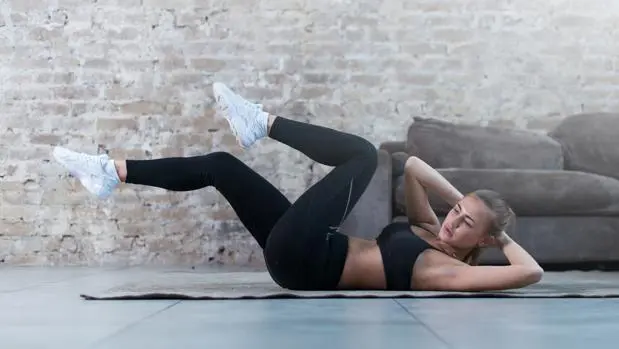
Crunch is the name of the short abdominal in English, hence this name has been adopted to refer to a series of exercises that mainly work the rectus abdominis although the oblique muscles are also involved. In general, it is the type of abdominal exercises in which lying on your back on the floor, the trunk is flexed, separating the scapulae from the ground.
It is an ideal exercise to practice at home since it does not require much space or any type of material, although there are variables in which you can incorporate weight or use elements such as balls. For that reason, it is one of the most practiced exercises and that have the best results since, in addition to working the abdominals, they involve other parts of the body such as the tensor fascia lata, located on the upper side of the thigh.
The key to crunch is that the lumbar area of the back must remain close to the ground to enhance the work of the abdominals and to avoid pain or injury.
Although for many years they seemed to be the only possible abdominals, their poor execution leads to various types of injuries, which has caused that in recent years they have given way in favor of other modalities such as the popular planks or other types of isometric exercises in which no movement is introduced or it is done in a timely manner to introduce intensity or greater activation.
With these exercises the muscles of the upper abdominal area and the general strengthening of the abdomen, favoring a better back health since a resistant abdomen helps to maintain a good posture and a better stability and mechanics of the body. With this it is achieved that the work of the lumbar is less and, therefore, they suffer less on a day-to-day basis.
Risks
Neck tension: it is one of the main risks. By placing the arms behind the neck, the neck can be pulled, causing excess tension in the neck and problems in the cervicals.
Spine– Excess curvature in flexion can cause lower back pain. To avoid this, you have to keep your lumbar muscles glued to the ground throughout the performance.
Wrong posture: can promote a hunched back and drooping shoulders.
Drill
Crunch normal: lying on a mat, bend your knees with your feet on the floor and cross your arms over your chest. Perform trunk lifting movements separating the scapulae from the floor while keeping the lumbar region glued to the ground.
Legs up: in the same position as above, the exercise can be intensified by lifting the feet and keeping the legs bent at 90 degrees. The execution is the same as in the normal crunch.
Crunch twist: lying on your back on a mat, with your feet on the floor and your knees bent, place your hands behind your neck and bring the right elbow to the left knee and the left elbow to the right knee alternately.
Fitball: perform trunk push-ups with your back supported by a pilates ball while maintaining balance and abdominal activation.
WeightThe normal crunch can be intensified by holding a weight on the chest or holding a dumbbell overhead.









